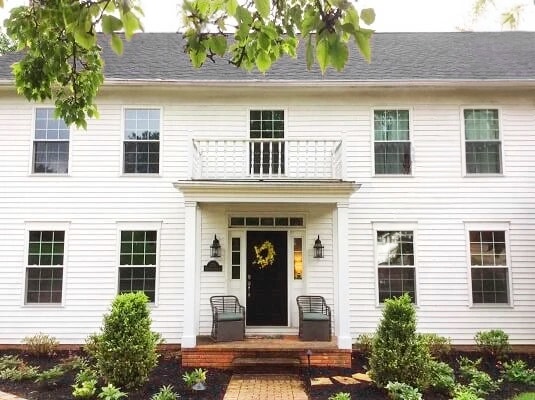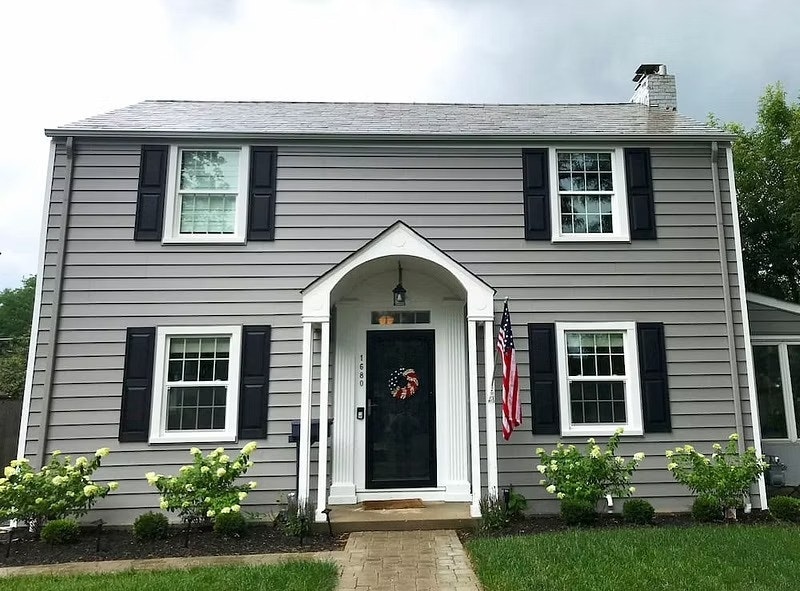Find the Right Window for Your Colonial-Style Home
A defining characteristic of charming colonial homes is their distinctive style of windows. Find out the specific elements that help further this style.

Published 2023-10-11

Colonial architecture is revered for its timeless elegance and classic charm, and one of the defining features of this style is its windows. Colonial windows play a pivotal role in capturing the essence of historical homes, showcasing a variety of types, colors, grille patterns and trim. In this article, let’s dive into the elements that make colonial windows an essential component of architectural history.

The History of Colonial Windows
Understanding the history behind colonial windows provides valuable insight into why they remain popular today. Colonial windows have a rich history dating back to the early days of American architecture. These windows were first introduced during the colonial period, which spanned from the 17th to the 18th century. During this time, colonial settlers sought to recreate familiar architectural styles from their origin in their new homes. This led to the development of distinct window designs that are now synonymous with colonial architecture.
Distinctive Window Elements Found in Colonial Homes
Windows are classic architectural features that add charm and character to colonial homes. They are known for their symmetrical layout and simple yet elegant details. Colonial windows are not just functional elements but also decorative pieces that enhance the architectural style of your home. Below are some of the defining characteristics of colonial windows:

1. Common Window Types
The most common types of colonial windows include double-hung windows, casement windows and picture windows. Each type has its own unique characteristics that can add a touch of elegance to your home./p>
Double-hung windows were popular and readily available during the colonial era, making them a classic and timeless choice even today. They feature two sashes that slide up and down within the frame, allowing for ventilation control. Double-hungs are commonly placed above ground level as both sashes tilt in for convenient cleaning.
Another option is casement windows. These windows swing outward on side hinges, creating a larger opening for maximum airflow. When used in a colonial-style home, homeowners typically select traditional grilles that further the historical look. We’ve seen some customers take it a step further by applying custom grilles that replicate the double-hung look while gaining the maximum ventilation benefit of a casement.
Picture windows are those that are unable to be opened. This is a popular choice for colonial homes as people appreciate the unique styles of special-shaped windows that are available. Arched or round-top windows add architectural interest and historical detailing that complement colonial style
No matter which type of replacement window you choose, you can customize the product to maintain the design integrity of your historic home while also benefitting from improved energy efficiency, easier operation and innovative features and options.
2. Window Colors True to Colonial Style
Colors play a significant role in capturing the colonial aesthetic. Traditional window color palettes often include muted earth tones such as whites, creams, soft grays and browns. At Pella, white and black windows are the most popular colors we see used on colonial-style homes. Many feature red brick exteriors or neutral siding. These colors evoke a sense of warmth and timelessness, enhancing the curb appeal of colonial homes.


3. Grille Patterns
Another defining characteristic of colonial windows is their divided panes or grille patterns. In the colonial era, windowpanes were small, and the technology didn’t yet exist to create larger pieces of glass. Accordingly, windows featured several small, divided panes of glass that became a hallmark of colonial style. Today, we are able to build one large pane of glass for a window which is more energy efficient than multiple small panes. To maintain historical accuracy, Integral Light Technology® or Simulated-Divided-Light grilles can be applied to the glass to achieve the look of individual windowpanes. Alternatively, grilles-between-the-glass are sealed between panes to create a smooth glass surface that’s easy to clean.
Colonial grille patterns often feature simple horizontal and vertical lines. Traditional, Top Row and Prairie grille patterns are most popular for those who want to achieve an authentic colonial look. The number of grids can vary depending on the style and size of the window. Below are some examples of common grille patterns used on colonial homes:

4. Trim and Shutters
The trim and shutters surrounding colonial windows play a crucial role in accentuating their beauty. Colonial architecture often features understated and symmetrical trim designs with shutters around the windows. The trim is usually the same color as the window frame, expanding the appearance of the window. Exterior window trim is typically flat, with clean lines that complement the overall aesthetic of these windows. In the Northeast region where colonial home styles are especially common, Pella now offers flat window casing attached directly to the frame of Pella® 250 Series single-hung and double-hung windows. This option is extruded off the exterior of the frame and factory-applied to make installation easier. On the interior, trim tends to be more ornate and detailed. It’s often a wide board with an ogee profiled edge or fluted trim that brings elegant courtliness to the home.


Colonial windows are a focal point of architectural styles that have stood the test of time. Their diverse types, understated colors, elegant grille patterns and timeless trim designs all contribute to the unique charm of colonial homes. These architectural elements continue to preserve a piece of history within the framework of modern living. By taking these factors into account when selecting colonial windows for your home, you'll be sure to find options that not only enhance its beauty but also meet your functional needs.
Reach out to a local Pella expert to find out how you can use windows to further colonial style.

